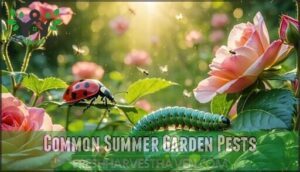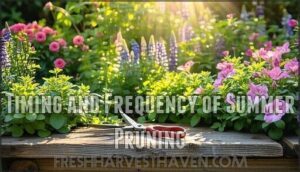This site is supported by our readers. We may earn a commission, at no cost to you, if you purchase through links.
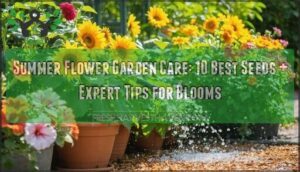 Summer flower garden care requires consistent attention to four key areas.
Summer flower garden care requires consistent attention to four key areas.
Water deeply in early morning to prevent evaporation and root rot. Apply mulch around plants to retain moisture and suppress weeds.
Deadhead spent blooms regularly to encourage continuous flowering throughout the season. Watch for common pests like aphids and spider mites, which thrive in hot weather.
Feed your flowers with balanced fertilizer every 4-6 weeks to maintain energy for blooming. Don’t forget to check soil moisture daily during heat waves, as containers dry out faster than ground plantings.
Smart plant selection and proper timing make all the difference, and remembering to check soil moisture is crucial for a healthy garden.
Table Of Contents
- Key Takeaways
- Essential Summer Garden Care Tips
- Combatting Summer Pests and Diseases
- Deadheading and Pruning for Continuous Blooms
- 10 Best Summer Flower Seeds
- 1. Giant Delphinium Seed Mix Pack
- 2. Lanceleaf Coreopsis Wildflower Seeds 5000 Count
- 3. Outsidepride 1000 Purple Gomphrena Globosa Flower Seeds
- 4. Lantana Flower Seeds Mixed Colors 100 Plus Pack
- 5. Heavenly Blue Morning Glory Flower Seeds
- 6. Portulaca Moss Rose Ground Cover Seed Mix
- 7. Giant Blue Purple Allium Globemaster Flower Seeds
- 8. Outsidepride Orange Sneezeweed Perennial Flower Seeds
- 9. Calamint Lesser Calamintha Nepeta Officinalis Seeds
- 10. Burpee Border Mix Geranium Seeds
- Extending Summer Blooms With Strategic Planting
- Frequently Asked Questions (FAQs)
- How to care for summer flowers?
- What is the rule of 3 in gardening?
- Should you water flowers everyday in the summer?
- When should you cut back summer flowers?
- How to take care of flowers in the summer?
- How often should I water my flower garden in summer?
- How to maintain the flower garden?
- Which flowers attract the most butterflies and hummingbirds?
- When is the best time to fertilize flowering plants?
- Can I move flowering plants during summer months?
- Conclusion
Key Takeaways
- Water deeply once or twice weekly in the early morning – You’ll prevent evaporation and root rot while encouraging stronger root systems that handle drought better than daily shallow watering.
- Deadhead spent blooms weekly to redirect energy – You’re forcing plants to produce new flowers instead of seeds, which keeps your garden blooming continuously throughout the summer season.
- Apply 2-3 inches of organic mulch around plants – You’ll retain up to 70% more soil moisture, keep roots 10-15 degrees cooler, and suppress weeds that compete for nutrients.
- Choose heat-tolerant varieties like zinnias, lantana, and marigolds – You’ll get reliable blooms that thrive in summer’s intense heat when cool-season flowers start to fade and struggle.
Essential Summer Garden Care Tips
Proper summer garden care keeps your flowers blooming strong through the season’s heat and challenges.
You’ll need to master watering techniques, apply mulch correctly, and watch for signs that your plants need extra attention during hot weather.
Watering Techniques for Summer
Summer’s heat demands strategic watering summer flowers for ideal growth.
Deep watering once weekly beats daily sprinkling—it encourages stronger root systems and drought tolerance.
Apply one inch of water directly to soil, avoiding foliage to prevent disease.
Morning watering timing reduces evaporation loss while soaker hoses provide efficient irrigation.
Check soil moisture with your finger before watering again.
Mulching for Moisture Conservation
Think of mulch as your garden’s summer insurance policy.
Your garden’s summer bodyguard—mulch protects against heat, drought, and weeds while you sleep.
A 2-3 inch layer of organic mulch around your flowers creates the perfect defense system against heat stress.
- Moisture retention: Reduces water evaporation by up to 70%
- Temperature control: Keeps soil 10-15 degrees cooler than bare ground
- Weed suppression: Blocks sunlight from reaching competing weeds
This simple step transforms soil structure while protecting root health.
Consider using organic options for gardens to further enrich the soil.
Recognizing Drought Stress in Plants
Wilting leaves, stunted growth, and leaf curling signal your plants are crying for water.
Color changes from vibrant green to dull yellow reveal drought stress taking hold.
Check for soil cracking around your summer flowers—it’s nature’s distress signal.
Proper watering summer flowers prevents these issues, while drought-resistant plants offer backup when heat waves hit your garden hard.
Combatting Summer Pests and Diseases
Summer heat brings unwanted guests like cucumber beetles, Japanese beetles, and fungal diseases such as powdery mildew that can damage your flower garden.
You’ll need to inspect your plants weekly and use organic methods like neem oil, proper watering techniques, and good air circulation to keep these problems under control.
Common Summer Garden Pests
Your flower garden faces an army of uninvited summer guests.
Pest identification helps you recognize troublemakers before they cause major damage.
Watch for these common summer flower pests:
- Spider mites – tiny red specks creating fine webbing
- Whiteflies – small white insects clustering under leaves
- Flea beetles – jumping black dots on foliage
- Scale insects – brown bumps on stems
Early detection prevents extensive garden pests damage.
Organic Pest Control Methods
Organic solutions tackle summer flower pests effectively without harsh chemicals.
Neem oil spray controls aphids and beetles while preventing fungal issues. You can find products with neem to help with this.
Mix insecticidal soap using dish soap and water for soft-bodied insects. Companion planting with garlic and dill naturally deters pests.
Attract beneficial insects like ladybugs by planting sweet alyssum—these natural predators handle pest control automatically, using organic solutions, neem oil spray, and companion planting.
Preventing Diseases Through Proper Care
Disease-resistant plants form your garden’s first line of defense against common flower garden diseases.
Proper watering techniques and soil health create conditions where pathogens struggle to thrive, while air circulation prevents moisture buildup that fuels fungal problems.
- Water at soil level – avoid splashing leaves to prevent disease spread
- Space plants properly – guarantee adequate air circulation between flowers
- Choose disease-resistant varieties – select proven cultivars for your region
- Practice early intervention – remove infected plant parts immediately
- Maintain soil health – healthy soil supports stronger, more resilient plants
Deadheading and Pruning for Continuous Blooms
You’ll keep your summer flowers blooming all season long by removing spent blooms and strategically pruning your plants.
Deadheading redirects your plant’s energy from seed production back into creating new flowers, while proper pinching techniques encourage fuller, bushier growth that produces more blooms throughout the summer months, which helps in deadheading.
Deadheading Techniques for Various Flowers
After tackling pests and diseases, proper deadheading becomes your secret weapon for continuous blooming.
Different flowers need specific approaches for ideal results.
| Flower Type | Deadheading Tools | Technique |
|---|---|---|
| Annuals (Marigolds, Zinnias) | Scissors or fingers | Cut 1/4 inch above new bud |
| Long-stemmed (Shasta Daisy) | Pruning shears | Remove entire stalk to ground |
| Soft-stemmed (Petunias) | Pinching fingers | Gentle removal of spent blooms |
Deadheading flowers redirects energy from seed prevention to bloom redirection, maintaining plant appearance and extending bloom time throughout summer flower care seasons.
Pinching Back for Bushy Growth
Pinching back perennials like mums, sedums, and asters until July creates bushier plants with increased bloom quantity.
This summer flower care technique removes growing tips, encouraging compact growth and multiple stems.
Different plant types require specific pinching timing – stop by mid-July to guarantee fall blooms.
Regular pinching transforms leggy plants into full, rounded specimens that’ll reward you with spectacular displays.
Timing and Frequency of Summer Pruning
Most perennials benefit from mid-summer pruning to encourage reblooming.
Deadhead spent flowers weekly, but save major pruning for early summer.
Pinch back perennials like mums and asters until July for bushier growth.
Flower-specific pruning varies—cut back early bloomers after flowering, while continuous bloomers need regular deadheading to maximize your summer flower bloom potential.
10 Best Summer Flower Seeds
You’ll find success with these ten carefully selected summer flower seeds that thrive in hot weather conditions and provide continuous blooms throughout the growing season.
These varieties offer reliable germination rates, heat tolerance, and low-maintenance care requirements that make them perfect choices for both beginning and experienced gardeners.
1. Giant Delphinium Seed Mix Pack
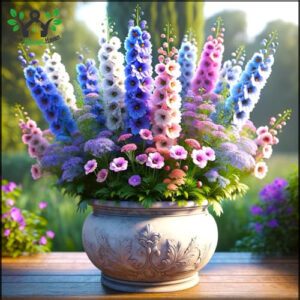
Towering beauties that command attention, Giant Delphinium seed mixes deliver spectacular spires reaching 3-6 feet tall.
You’ll get closely packed blossoms in stunning shades of pink, violet, and blue that attract hummingbirds while keeping deer away.
These hardy perennials thrive in USDA zones 3-7 with full sun exposure, and they should be planted 1-2 weeks after your last frost when soil hits 60-70°F.
They’ll bloom from spring through early summer, creating dramatic vertical interest that transforms any garden into a showstopper.
Best For: Gardeners in USDA zones 3-7 who want tall, vibrant, perennial flowers that attract pollinators while deterring deer.
- Stunning, closely packed flowers in shades of pink, violet, and blue.
- Hardy perennial that thrives in full sun and blooms from spring to early summer.
- Attracts hummingbirds and pollinators while being deer resistant.
- Requires specific planting timing based on frost dates and soil temperature.
- Needs full sun and well-drained soil for optimal growth.
- May grow too tall (3-6 feet) for certain smaller garden spaces.
2. Lanceleaf Coreopsis Wildflower Seeds 5000 Count
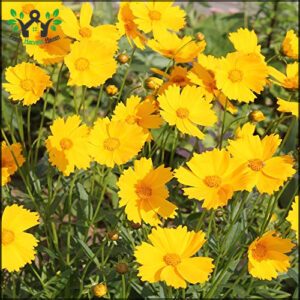
Looking for reliable summer blooms? Lanceleaf Coreopsis wildflower seeds deliver thousands of golden flowers that thrive in poor, well-drained soil with full sunlight needs.
These drought-tolerant beauties require minimal watering once established, making Coreopsis propagation effortless.
Plant them alongside native grasses as companion plants for stunning wildflower meadows that support pollinators throughout your summer flower garden care routine, creating a perfect environment for pollinators.
3. Outsidepride 1000 Purple Gomphrena Globosa Flower Seeds

Purple Gomphrena delivers show-stopping globe-shaped blooms that’ll transform your summer garden into a butterfly magnet. You’ll love how these drought-tolerant champions thrive in poor soils and blazing heat, making them perfect for challenging spots.
Plant 1-2 seeds 18 inches apart in well-drained soil, and you’ll see germination in 7-10 days. These 24-inch beauties work double duty as fresh cuts or dried arrangements.
While some gardeners report mixed germination rates, protect young seedlings from deer and you’ll enjoy vibrant purple pom-poms all season long.
Best For: Gardeners looking for low-maintenance, drought-tolerant flowers that attract pollinators and work well in both fresh and dried arrangements.
- Drought-tolerant and thrives in full sun and poor soils.
- Attracts butterflies and is naturally deer-deterrent.
- Versatile for beds, borders, containers, and floral arrangements.
- Mixed germination rates reported by users.
- Seed count discrepancies and unexpected color variations.
- Seedlings require protection from deer.
4. Lantana Flower Seeds Mixed Colors 100 Plus Pack
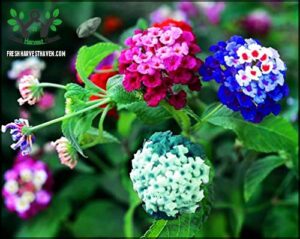
With over 200 mixed-color seeds in each pack, lantana delivers reliable summer performance that’ll make your neighbors jealous.
These heirloom beauties thrive in full sun and attract butterflies, bees, and hummingbirds like a magnet.
You’ll love how drought-tolerant they become once established, requiring minimal fuss while producing vibrant blooms in pink, yellow, red, and orange.
Perfect for containers or mass plantings, lantana keeps flowering until frost hits, and with weekly watering once mature, it’s all they need to transform your garden into a pollinator paradise.
Best For: Gardeners looking for easy-to-grow, drought-tolerant heirloom flowers that attract pollinators and thrive in full sun.
- Over 200 mixed-color seeds in each pack, with vibrant multicolored blooms.
- Attracts butterflies, bees, and hummingbirds, enhancing garden biodiversity.
- Low maintenance, drought-tolerant, and blooms until frost.
- Requires full sun for optimal growth, limiting shade planting options.
- Needs regular watering during the establishment phase.
- May require well-draining, fertile soil to thrive.
5. Heavenly Blue Morning Glory Flower Seeds
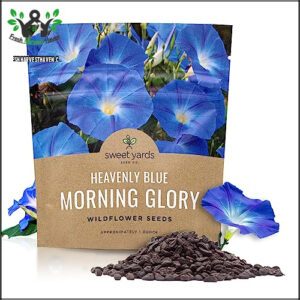
These vigorous climbers deliver stunning 5-inch blue blooms that’ll transform any vertical space into a summer showstopper.
You’ll get over 1,000 seeds in each pack, covering up to 75 square feet of trellises, fences, or arbors.
Plant them in full sun with eastern exposure for best results.
They’re fast-growing and attract pollinators while staying deer-resistant.
Just remember they’re toxic if eaten, so keep pets and kids away.
These morning glories self-seed readily, giving you natural returns next season.
Best For: Gardeners looking for fast-growing, vibrant blue flowering climbers to enhance vertical spaces and attract pollinators.
- Over 1,000 seeds can cover up to 75 square feet.
- Long-lasting, striking blue blooms that attract bees and butterflies.
- Deer-resistant and self-seeding for natural regrowth.
- Toxic if ingested by humans or animals.
- Requires full sun and proper care for optimal growth.
- Not perennial, needs planting each year in some climates.
6. Portulaca Moss Rose Ground Cover Seed Mix
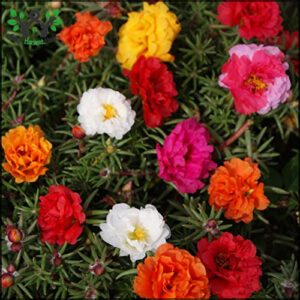
Portulaca moss rose transforms bare spots into colorful carpets with minimal effort.
These drought-resistant plants thrive in full sun and well-drained soil, making them perfect ground cover plants for challenging areas.
Portulaca propagation happens naturally through self-seeding, while their pest resistance means you’ll spend less time troubleshooting.
Water sparingly once established for best summer flower garden care results, utilizing their drought-resistant nature.
7. Giant Blue Purple Allium Globemaster Flower Seeds
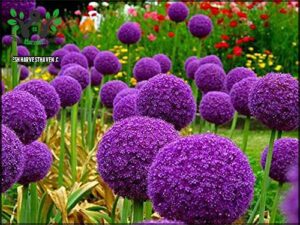
Giant blue purple Allium Globemaster creates stunning architectural statements in your flower garden with their massive spherical blooms.
These towering giants reach impressive heights, making them perfect focal points among other summer flower types.
Plant bulbs in fall for spectacular spring displays.
Their drought tolerance and deer resistance make Globemaster Care surprisingly simple, while purple blooms complement most garden color schemes beautifully, and their massive spherical blooms are a key feature.
8. Outsidepride Orange Sneezeweed Perennial Flower Seeds
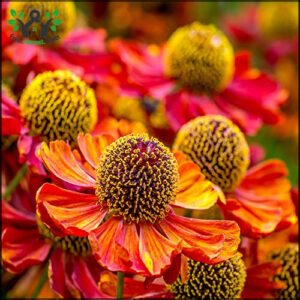
Orange sneezeweed transforms late summer gardens into blazing displays of daisy-like blooms. These robust perennials meet sneezeweed sun requirements with full sun exposure, while sneezeweed soil needs include well-drained, average soil.
Sneezeweed bloom time extends from summer through fall frost. For sneezeweed propagation, start seeds indoors eight weeks before frost.
Growing summer flowers becomes effortless with sneezeweed companion plants like shasta daisies and ornamental grasses.
9. Calamint Lesser Calamintha Nepeta Officinalis Seeds
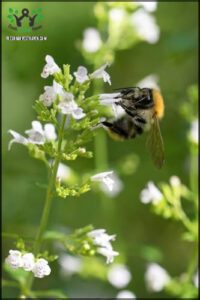
Calamint’s aromatic leaves and delicate flowers make it a standout choice for your summer flower garden.
This Mediterranean herb thrives in poor soil and attracts beneficial pollinators while deterring pests naturally.
- Calamint Cultivation: Plant in well-draining soil with full sun exposure
- Calaminth Medicinal Uses: Traditional remedy for digestive and respiratory issues
- Calaminth Companion: Pairs perfectly with roses, tomatoes, and other herbs
- Calamint Propagation: Easy from seed or division in spring
10. Burpee Border Mix Geranium Seeds

Burpee’s Border Mix Geranium seeds wrap up our top ten with classic garden charm.
These compact plants produce stunning 5-inch flower heads in cherry, scarlet, deep rose, orange-scarlet, and white.
You’ll get 10 seeds per packet that germinate reliably when started indoors 10 weeks before your last frost date.
Their bushy 15-inch height makes them perfect for containers and borders.
These annuals bloom continuously through summer with full sun and proper care, delivering old-fashioned beauty that never goes out of style, providing a perfect display of summer blooms.
Best For: Gardeners looking for vibrant, compact, and easy-to-grow flowers for borders, containers, and sunny spaces.
- Stunning 5-inch flower heads in a variety of vibrant colors.
- Compact, bushy plants ideal for small spaces and containers.
- Blooms continuously through summer with proper care.
- Only 10 seeds per packet, which may limit planting options.
- Germination rates may vary, depending on conditions.
- Requires advance indoor sowing, which takes planning and effort.
Extending Summer Blooms With Strategic Planting
You can keep your garden blooming from spring through fall by replacing tired spring annuals with heat-tolerant varieties like lantana, zinnia, and angelonia that thrive in summer’s intense conditions.
Strategic timing of summer-blooming bulbs and proper care of perennials guarantees continuous color when other plants start to fade in the heat.
Replacing Spring Annuals With Heat-Loving Varieties
Once your spring annuals start looking tired and leggy, it’s time for summer annual selection.
Replace faded flowers with heat-tolerant annuals like angelonia, lantana, and zinnia for extending bloom season.
These colorful replacements thrive in summer heat while your cool-season plants struggle.
Post-spring planting with heat-loving plants keeps your garden vibrant through the hottest months.
Summer-Blooming Bulbs for Late-Season Color
Smart bulb selection transforms gardens with late-season drama.
Plant summer-blooming bulbs like dahlias and gladiolus after frost danger passes for spectacular autumn displays.
Proper soil preparation and consistent watering needs guarantee robust growth.
These flower garden maintenance stars deliver vibrant summer flower bloom when other plants fade.
Consider browsing a retailer for summer flowering bulbs to expand your options.
Store tender bulbs indoors during winter for next year’s flower garden tips success, ensuring a beautiful display of summer-blooming bulbs and vibrant summer flower.
Caring for Perennials for Continued Blooms
Your existing perennials need attention beyond summer flower planting for maximum summer flower bloom.
Deadheading spent flowers redirects energy toward new buds while fertilizing flowers monthly supports continuous growth.
Check sun requirements match their location, enrich soil with compost, and consider perennial division for overcrowded clumps.
Proper flower garden maintenance and bloom boosting techniques guarantee spectacular displays through fall, preparing plants for winter protection.
Frequently Asked Questions (FAQs)
How to care for summer flowers?
Water your summer flowers deeply once or twice weekly, deadhead spent blooms regularly, and apply two-inch mulch layers.
Choose heat-tolerant varieties like zinnias and lantana for continuous color throughout the season.
What is the rule of 3 in gardening?
Plant three of the same flower variety together to create visual impact and cohesion in your garden design.
This grouping principle helps establish focal points, prevents scattered looks, and makes maintenance easier while maximizing aesthetic appeal.
Should you water flowers everyday in the summer?
Like a steady heartbeat, consistency trumps frequency when watering flowers.
You shouldn’t water daily—instead, give them deep soaks 1-2 times weekly.
This encourages stronger roots and prevents shallow, weak growth patterns.
When should you cut back summer flowers?
Cut back summer flowers when they’re spent or faded to encourage reblooming.
Deadhead weekly using clean, sharp shears.
This redirects energy from seed production to new blooms, keeping your garden vibrant throughout the season.
How to take care of flowers in the summer?
Most gardeners lose 40% of their plants due to overwatering during summer heat.
You’ll need deep weekly watering, morning schedules, mulching for moisture retention, and regular deadheading to keep blooms thriving through scorching temperatures, which involves careful management to prevent overwatering.
How often should I water my flower garden in summer?
Water your flower garden deeply once or twice weekly during summer, providing about one inch total.
Morning watering reduces evaporation, while soaker hoses deliver water efficiently to roots without wetting foliage.
How to maintain the flower garden?
While maintenance seems overwhelming, you’ll actually save time with consistent care.
Deadhead spent blooms weekly, water deeply twice weekly, mulch around plants, and remove weeds promptly to keep your garden thriving beautifully.
Which flowers attract the most butterflies and hummingbirds?
Butterflies flock to lantana, coreopsis, and globe amaranth for their nectar-rich blooms.
Hummingbirds can’t resist azaleas’ bright funnel-shaped flowers and morning glories’ bold trumpet blooms.
You’ll create a pollinator paradise with these stunning choices, including nectar-rich blooms.
When is the best time to fertilize flowering plants?
Feed your flowering plants in early spring when they’re waking up from winter’s rest.
You’ll want to apply a balanced fertilizer every 4-6 weeks during the growing season for continuous blooms.
Can I move flowering plants during summer months?
You can relocate flowering plants during summer, but it’s risky business.
Early morning or evening moves work best when temperatures cool down.
Water thoroughly beforehand and expect some transplant shock afterward.
Conclusion
Mastering summer flower garden care isn’t rocket science, but it’ll transform your outdoor space into a blooming paradise that’ll make neighbors green with envy.
You’ve got the essential techniques now: deep watering, strategic mulching, pest management, and deadheading for continuous blooms.
These ten seed varieties will give you months of color when planted with proper timing.
Remember, consistent daily attention beats sporadic weekend marathons.
Your flowers depend on you for survival during scorching summer months, so stay vigilant and enjoy the spectacular results.
- https://www.gardenersworld.com/how-to/grow-plants/how-to-grow-delphiniums/
- https://www.gardeningknowhow.com/edible/herbs/bacopa-plants/brahmi-plant-care-and-uses.htm
- https://www.instagram.com/p/DKCMz1UOJID/
- https://www.amazon.com/Lantana-Flower-Seeds-Planting-Mixed/dp/B0C5LHC25V
- https://www.outsidepride.com/seed/flower-seed/helenium/helenium-hoopesii.html?srsltid=AfmBOoo5Y-_EhHMCUuAl-BhMWqQrTCKn1CajfPd3aKctnrqnyMs3-J61

